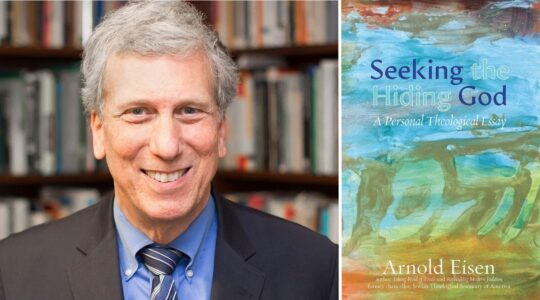Rabbi Sidney Schwarz recalls the exact words of a comment from a liberal rabbinical student that disturbed him profoundly.
“We were at a retreat, and he said to me, ‘I didn’t go to rabbinical school to carry the tribal water of the Jewish people.’ And I thought, ‘that is the job of a rabbi.’”
Rabbi Schwarz, founder and leader of a Reconstructionist congregation in suburban Maryland, says the encounter was not atypical of a select group of progressive Jews who are deeply committed to Jewish life — but not to the agenda of an organized Jewish community perceived as “obsessed by continuity.”
Calling for a new way to reach these and many other young Jews, most of whom eschew the term “Zionist,” Rabbi Schwarz has come up with an unusual approach in his new book, “Jewish Megatrends: Charting the Course of the American Jewish Future” (Jewish Lights Publishing). It opens with his thesis on how to engage the majority of young Jews who show little interest in traditional forms of affiliation — synagogues, organizations, Federation — and then asks 13 leading Jewish innovators to each write a chapter in response to his views, based on their own observations about what works and what doesn’t.
He closes the book with a rebuttal of sorts, “fine tuning” his initial thoughts and charting an upbeat path for an American Jewish community he views as “in transition” rather than “in decline.”
The result is a compelling overview of the stand-out successes and major challenges in confronting a generation many believe is moving away from its parents’ and grandparents’ ways of identifying Jewishly, and in charting a course for engaging it in ways it can relate to, authentically.
Rabbi Schwarz has the credentials for this effort. Besides his rabbinic duties, he is known nationally as a social and political activist, and founder of Panim, a group he led for two decades that trained teens for leadership through Jewish education, values and social responsibility. He is also the author of two previous books, one exploring the key to successful synagogue models (“Finding A Spiritual Home”) and the other (“Judaism and Justice”) on the power of social justice in engaging young people.
Those themes form the core of “Jewish Megatrends,” in which Rabbi Schwarz identifies a growing polarization between what he describes as two types of Jews. One, like himself, he dubs “tribal Jews”; they identify strongly with Israel and worry about external and internal threats to Jewish continuity. The other he terms “covenantal Jews”; they are primarily made up of younger people who are less parochial, less concerned about group solidarity, and more interested in universal themes like justice and human dignity.
Rabbi Schwarz argues that the organized Jewish community, led by tribal Jews, is in effect driving away covenantal Jews by “drawing hard and fast lines on who does and who does not belong to the Jewish community.” He says “rabbis and the organized Jewish community are notoriously bad at understanding and validating” those whose Jewish identity is “soft and highly ambivalent,” but who can be engaged through programs that connect them to universal and liberal values stemming from their Jewish heritage.
The key, he says, is to reach these “covenantal Jews” from the outside-in rather than the inside-out approach. In other words, don’t begin by preaching Jewish texts, which they see as irrelevant. Rather, “start with what matters” to sophisticated, thoughtful Jews, like their commitment to improve the world, and show them how these goals can be advanced through Jewish wisdom and spirituality. That means tracing social justice to ancient Jewish values, and offering a caring community and “sacred purpose” to their lives.
Don’t try to give them Judaism-lite, Rabbi Schwarz insists, but “raise the bar” in terms of content and commitment. If you’re serious with them, they’ll take you more seriously. And don’t be afraid to proclaim Jewish life as countercultural, emphasizing personal relationships in an era so dependent on technology that people prefer texting to meeting face to face.
The main section of the book is made up of chapters on innovations in Jewish culture (by Elise Bernhardt), synagogues (Rabbi Sharon Brous), family foundations (Sandy Cardin), Israel (Barry Chazan and Anne Lanski), denominationalism (Rabbi David Ellenson), “getting” the next generation (Wayne Firestone), Jewish social justice (Rabbi Jill Jacobs), community centers (Rabbi Joy Levitt), the Orthodox difference (Rabbi Asher Lopatin), interreligious collaboration (Rabbi Or N. Rose), tribes, food and community (Nigel Savage), the federation system (Barry Shrage), and Jewish education (Jonathan Woocher).
Support the New York Jewish Week
Our nonprofit newsroom depends on readers like you. Make a donation now to support independent Jewish journalism in New York.
Most agree, to varying degrees, with Rabbi Schwarz’s basic premise and approach, giving examples of how they try to provide authentic experiences to a younger generation for whom Israel and the Holocaust hold increasingly less appeal. For example, both Wayne Firestone, outgoing president and CEO of Hillel, and Jonathan Woocher, a leader in innovative Jewish education, make the point that Jewish students aren’t trying to “fit in,” as their parents did, but are seeking ways to live more meaningful lives through Judaism. Rabbi Ellenson, the president of Hebrew Union College, notes that young Jews are not interested in denominational labels. And Rabbi Brous, who leads a popular synagogue in Los Angeles, emphasizes that the more demands she makes on her congregation members in terms of attendance and commitment, the better they respond.
Only Barry Shrage, the chief executive of the Jewish Federation in Boston, seriously challenges Rabbi Schwarz, arguing that the author’s “tribal” and “covenantal” depiction is an inaccurate stereotype, and that in truth the younger generation is more nuanced in terms of Jewish identity. For example, he says some may care deeply about the Palestinians’ plight but far more worry about Israel’s security.
Most significantly, he believes Birthright Israel has had a profound positive impact on young Jews, and he argues against dismissing tribal Judaism. “Not only is a ‘tribal-free’ Judaism inconceivable,” he writes, “it is also not necessary to attract the next generation of Jews.” That can and must be done, according to Shrage, largely in the ways Schwarz calls for.
The hopeful note throughout is that the contributors to “Jewish Megatrends” are seeking and finding creative ways to make Judaism compelling to people who are not just seeking to balance their American and Jewish identities, as did their parents and grandparents, but are looking to Judaism to provide deeper value in their lives. The question is whether these innovators are reaching enough Jews to make a difference, and if the rest of us are paying attention.
The New York Jewish Week brings you the stories behind the headlines, keeping you connected to Jewish life in New York. Help sustain the reporting you trust by donating today.





